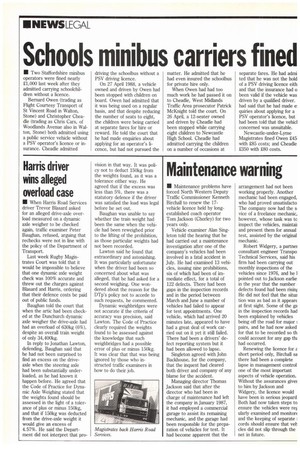Harris driver vans alleged overload case
Page 12

If you've noticed an error in this article please click here to report it so we can fix it.
• When Harris Road Services driver Trevor Blasard asked for an alleged drive-axle overload measured on a dynamic axle weigher to be checked again, traffic examiner Peter Baughan, refused, arguing that rechecks were not in line with the policy of the Department of Transport Last week Rugby Magistrates Court was told that it would be impossible to believe that one dynamic axle weight check was 100% accurate and threw out the charges against Blasard and Harris, ordering that their defence costs be paid out of public funds.
Baughan told the court that when the artic had been checked at the Dunchurch dynamic axle weigher the drive-axle had had an overload of 630kg (6%), despite an overall train weight of only 34,400kg.
In reply to Jonathan Lawton, defending, Baughan said that he had not been surprised to find an excess on the driveaxle when the steering axle had been substantially underloaded, as he had known it happen before. He agreed that the Code of Practice for Dynamic Axle Weighing stated that the weights found should be assessed in the light of a tolerance of plus or minus 150kg, and that if 150kg was deducted from the drive-axle weight it would give an excess of 4.57%. He said the Department did not interpret that pro
vision in that way. It was policy not to deduct 150kg from the weights found, as it was a tolerance either way. He agreed that if the excess was less than 5%, there was a statutory defence if the driver was satisfied the load was legal before he set out.
Baughan was unable to say whether the train weight had been the same when the vehicle had been reweighed prior to the lifting of the prohibition, as those particular weights had not been recorded.
Lawton said he found that extraordinary and astonishing. It was particularly unfortunate when the driver had been so concerned about what was alleged, that he had asked for a second weighing. One wondered about the reason for the Dip's policy not to accede to such requests, he commented.
Dynamic weighbridges were not accurate if the criteria of accuracy was precision, said Lawton. The Code of Practice clearly required the weights found to be assessed against the knowledge that such weighbridges had a possible error of plus or minus 150kg. It was clear that that was being ignored by those who instructed traffic examiners in how to do their job.


























































